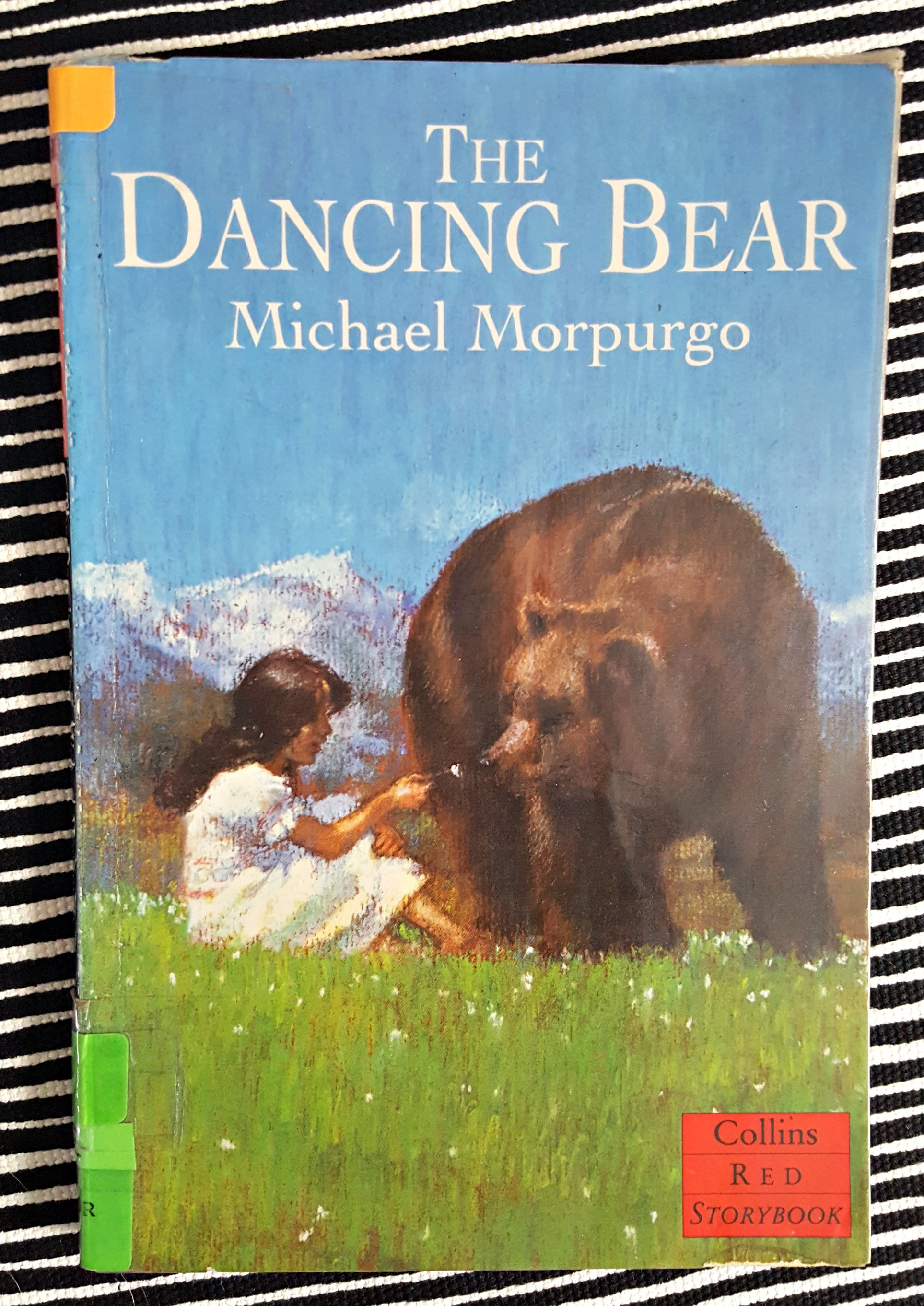Yesterday, while watching BBC news, a segment about dancing bears caught my attention. Initially, my reaction, like many others sensitive to animal suffering, was to quickly change the channel. The thought of animal cruelty is often too distressing to witness. However, before I could reach for the remote, the voice of Dr. Amir Khalil resonated through the television. His tone was kind yet authoritative, and hopeful, compelling me to stop and watch. I am grateful that I did. Dr. Khalil, a veterinarian with the charity Four Paws, was speaking about the establishment of bear sanctuaries in Bulgaria, a powerful reminder that the cruel practice of forcing bears to dance can be stopped. This glimpse into hope sparked a deeper reflection on the issue, prompting me to revisit Michael Morpurgo’s book, The Dancing Bear.

Image alt text: The book cover for Michael Morpurgo’s “The Dancing Bear” featuring a young girl and a bear silhouetted against a sunset, promoting children’s literature and animal stories.
The Dancing Bear is a book I often recommend for young readers in grades 3-5, part of the Collins Young Lions series, categorized as “longer satisfying stories – ideal for confident young readers.” Written by Morpurgo, it’s usually a solid choice. The story centers on Roxanne, an orphaned girl who discovers a bear cub. Her miserly grandfather reluctantly agrees to keep the cub, named Bruno, only when convinced it can be a source of income. Roxanne and Bruno develop a strong bond. However, an incident where Bruno playfully “swiped” at a child leads to village demands for the bear to be sent to a zoo. Roxanne passionately pleads to keep him, promising to build a cage and ensure he never harms anyone again.
A cage is erected in the village square, and Roxanne’s grandfather, capitalizing on the situation, puts up a sign:
Bruno European Bear
Help Save Threatened Species
Donations in the box please.
Bruno’s presence attracts a film crew who want to feature him in a music video for the singer ‘Niki’. Niki’s request? A dancing bear. Roxanne’s grandfather, ever opportunistic, assures them Bruno can dance.
“Oh, he’ll dance all right,” said Roxanne’s grandfather, rubbing his hands. “That bear can do anything you ask, can’t he, Roxanne?” Roxanne said nothing. She didn’t need to. The anger in her eyes said it all.
The story takes an unexpected turn when the music video becomes a Pied Piper remake, involving the entire village. Roxanne, surprisingly, gets Bruno to dance by singing, as Bruno enjoys her music and responds with a little jig. Everyone is pleased, especially Niki, who is so impressed with Roxanne that he takes her away to launch her own singing career. And Bruno? Bruno tragically dies alone in his cage. The narrative leaves the cause of his death ambiguous – grief, starvation, neglect, or perhaps envy at not becoming a pop star himself. The book abruptly concludes with the narrator mentioning a hat that didn’t fit, seemingly dismissing Bruno’s fate entirely. The hat. That’s right. The hat. No further details about the bear.
This ending leaves much to be desired. Even with a vivid imagination and literary understanding, the meaning remains elusive. Is it about change, inevitable progress, or simply ill-fitting hats?
Despite positive reviews and classroom use, The Dancing Bear is, in my opinion, deeply disappointing. A few sentences explaining Niki’s desire for a dancing bear or a character voicing concern about Bruno’s caged existence could have sparked crucial conversations about dancing bears and the ethics of keeping wild animals as pets. Instead, the book risks leaving children with the impression that bears enjoy dancing to music and that caging a wild animal is acceptable as long as you “love it.” This is a missed opportunity to educate young readers about a serious animal welfare issue. To truly understand the plight of dancing bears, searching for a Dancing Bear Full Video online can provide a stark and necessary contrast to the book’s narrative. These videos often reveal the harsh realities behind the practice.
Using The Dancing Bear Responsibly in Education
If The Dancing Bear is part of your curriculum, it’s crucial to consider the work of organizations like Four Paws and Dr. Amir Khalil. Supplementing the book with educational videos, even short ones, can help children understand why the concept of dancing bears is inherently cruel and wrong. A dancing bear full video from a reputable animal welfare organization can be a powerful tool to educate students on the suffering these animals endure.
Another Michael Morpurgo novel, Mr Nobody’s Eyes, also falls short in character development, particularly concerning its animal character.

Image alt text: Book cover for “Mr Nobody’s Eyes” by Michael Morpurgo, featuring a close-up of a chimpanzee’s face, highlighting themes of animal companionship and stories for young readers.
Mr Nobody’s Eyes tells the story of young Harry Hawkins, overwhelmed by grief and self-pity after his father’s death in WWII. He runs away from home with a chimpanzee, Ocky, for company. Harry’s life feels unstable: his father is gone, his mother has remarried and had another baby, and he’s struggling at school. His only solace is a “den” in a bombed-out cellar and his friends, an old clown and Ocky. When Ocky escapes, Harry takes her to his den. Eventually, they flee to the seaside. In a dramatic scene, Harry’s stepfather rescues Ocky from drowning. After a reunion with the clown, Harry decides to improve his life.
A Kirkus review accurately points out:
Young Harry Hawkins–overwhelmed by misery and self-pity–runs away from his postwar London home with a chimpanzee as company… The characters here (even, disappointingly, Ocky) are drawn with traditional British understatement… but the plot is well-knit; and several scenes… are startlingly vivid.
The character of Ocky is indeed underdeveloped. The story’s credibility suffers because of this, especially given the title and cover, which suggest Mr. Nobody is the chimpanzee. Similar to The Dancing Bear, Mr Nobody’s Eyes misses an opportunity. A note about circus animals or chimpanzees being endangered could have encouraged students to consider Ocky as a character with deeper needs and a life beyond entertainment. Reading the book at face value might lead children to believe that chimpanzees are happy performers and that returning Ocky to the circus is the right resolution. Again, searching for a dancing bear full video, or videos about chimpanzees in captivity, can offer a crucial contrasting perspective.
Using Mr Nobody’s Eyes to Encourage Critical Thinking
When using Mr Nobody’s Eyes in the classroom, consider linking it to units on habitats, home, and family. Encourage students to question what makes a place “home.” Harry’s playground is a bomb site, and his family has changed drastically. Mr. Nobody ran away to join the circus as a child. What is Ocky’s home like? What would her natural habitat be? Do chimpanzees live in family units like humans? These questions can enrich character analysis and prompt critical thinking about animals, including endangered species, used for human entertainment. By supplementing the book with discussions and resources, including perhaps a dancing bear full video to broaden the animal welfare conversation, educators can guide children to think critically about the stories they read and the world around them.

